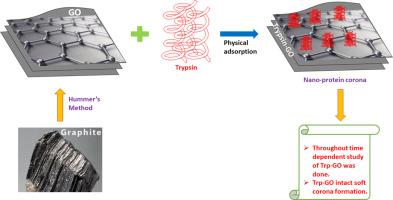International Journal of Biological Macromolecules ( IF 7.7 ) Pub Date : 2020-09-20 , DOI: 10.1016/j.ijbiomac.2020.09.099 Sujata Kumari 1 , Pratibha Sharma 1 , Debasree Ghosh 1 , Manish Shandilya 1 , Pooja Rawat 2 , Md Imtaiyaz Hassan 3 , Ranjita Ghosh Moulick 4 , Jaydeep Bhattacharya 5 , Chandramohan Srivastava 1 , Sudip Majumder 1

|
Understanding of interactions of nanomaterials with biomolecules (especially proteins) is of great importance to the area of nanobiotechnology. Graphene and its derivative such as graphene oxide (GO), are two-dimensional (2-D) nanomaterials with remarkable physical and chemical properties and have been broadly explored in biotechnology and biomedical application. Here, we have reported the nature of adsorption of trypsin on the GO surface, considering its biomedical implications. A simple incubation of trypsin on GO surface exhibits varying resistance to autolysis. The structural morphology of trypsin on the GO surface was studied by using atomic force microscopy (AFM), circular dichroism (CD), fluorescence, and total internal reflection fluorescence (TIRF) microscopies. Results suggest that the trypsin follows the Freundlich Isotherm. By the Langmuir model, the maximum adsorption capacity was found to be 100 mg/g. From protein assay results we have concluded that the native trypsin exhibits the highest catalytic efficiency (33.97*104 L mol−1 min−1) in comparison to other Trp-GO constructs. We have further visualized morphological change on GO-trypsin interface throughout the adsorption process by taking samples at definite time intervals, which suggests that the interaction of trypsin with GO is an example of the soft corona. Our findings may be implicated in enzyme engineering as well as enzyme-based bio-sensing applications.
中文翻译:

氧化石墨烯-胰蛋白酶吸附界面的时变研究和纳米蛋白质电晕的可视化。
了解纳米材料与生物分子(尤其是蛋白质)之间的相互作用对纳米生物技术领域非常重要。石墨烯及其衍生物,例如氧化石墨烯(GO),是具有显着物理和化学特性的二维(2-D)纳米材料,在生物技术和生物医学应用中得到了广泛的探索。在这里,考虑到其对生物医学的影响,我们已经报道了胰蛋白酶在GO表面的吸附性质。胰蛋白酶在GO表面上的简单孵育表现出对自溶作用的不同抵抗力。通过使用原子力显微镜(AFM),圆二色性(CD),荧光和全内反射荧光(TIRF)显微镜研究了GO表面上胰蛋白酶的结构形态。结果表明,胰蛋白酶遵循弗氏等温线。通过Langmuir模型,发现最大吸附容量为100mg / g。根据蛋白质测定结果,我们得出结论,天然胰蛋白酶显示出最高的催化效率(33.97 * 10与其他Trp-GO构建体相比,为4 L mol -1 min -1)。我们通过在确定的时间间隔取样来进一步观察整个吸附过程中GO-胰蛋白酶界面上的形态变化,这表明胰蛋白酶与GO的相互作用是软电晕的一个例子。我们的发现可能与酶工程以及基于酶的生物传感应用有关。









































 京公网安备 11010802027423号
京公网安备 11010802027423号